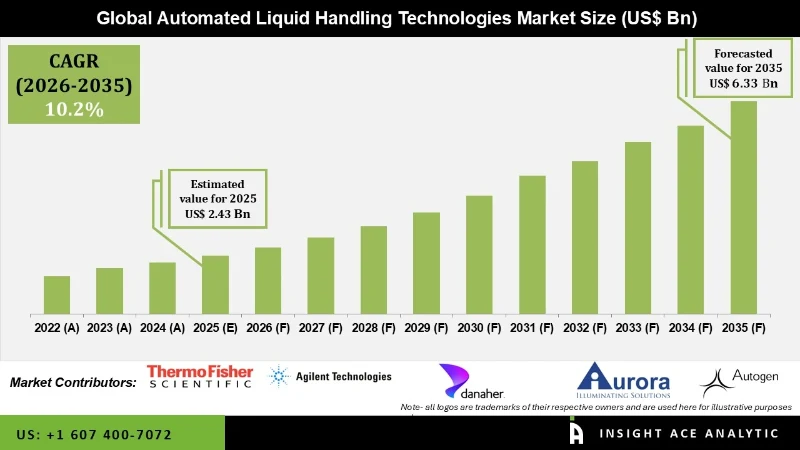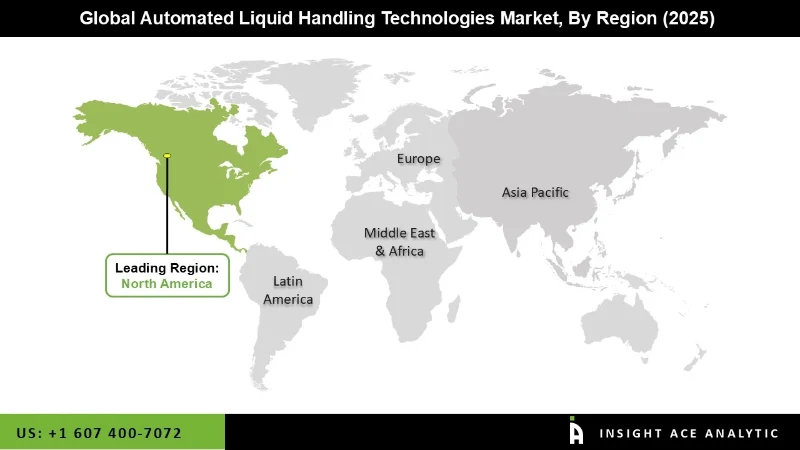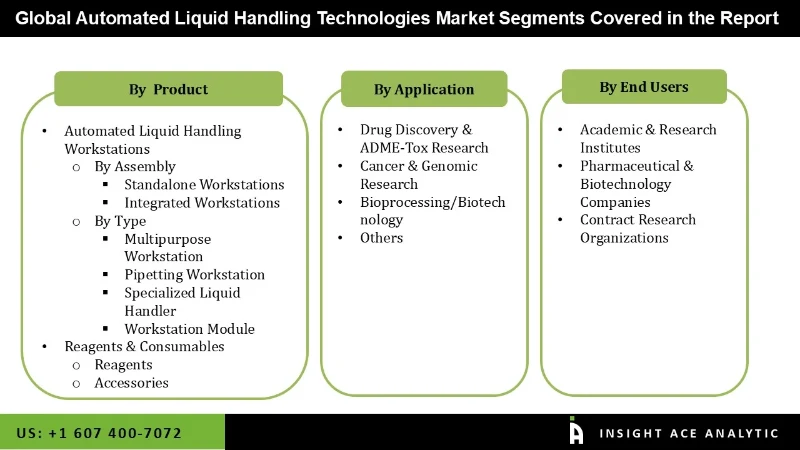Automated Liquid Handling Technologies Market Size is valued at 2.43 Bn in 2025 and is predicted to reach 6.33 Bn by the year 2035 at an 10.2% CAGR during the forecast period for 2026 to 2035.
Automated Liquid Handling Technologies Market Size, Share & Trends Analysis Report By Product (Automated Liquid Handling Workstations, Reagents & Consumables), By Application, By End-users, Region, And Segment Forecasts, 2026 to 2035

Automated liquid handling instruments involve the integration of automated technologies into laboratories to improve the operations in various daily laboratory experiments such as pipetting and data analysis. These instruments offer several advantages, including ease of dispensing and sampling liquids in tubes, enhanced quality, accuracy and reproducibility, and minimal requirement for manual work. Automated liquid handling also improved the next-generation sequencing outcomes.
The need for liquid handling automation systems is growing as the guidelines for pharmaceutical liquid handling are constantly changing. Further, the ability of automated liquid handling systems to handle small amounts of liquid more efficiently and the increasing demand for miniaturization are the key drivers of the automated liquid handling technologies market expansion.
Moreover, manufacturers are also investing in innovating advanced and automated liquid handling technologies. For instance, in February 2022, Festo launched a modular gantry robot platform for an automated liquid handling system used in laboratories. This new solution enables equipment designers to realize their distinctive solutions quickly. In December 2021, Flow Robotics A/S and Automata collaborated to offer end-to-end automation of liquid handling in laboratories with the pipetting robot, flowbot® ONE, and the robot arm, Eva.
The advantages of automated liquid handling instruments include high production rates & increased productivity, more efficient use of materials, improved safety, better product quality, shorter labour work, and reduced factory lead times.
The Automated Liquid Handling Technologies Market is segmented based on product, application, and end-users. The product segment includes automated liquid handling workstations, reagents & consumables. The automated liquid handling workstations segment is further divided into assembly (standalone workstations and integrated workstations) and type (Multipurpose Workstation, Pipetting Workstation, Specialized Liquid Handler, and Workstation Module).
The reagents & consumables segment is further divided into reagents and accessories. Application segment includes cancer & genomic research, drug discovery & ADME-Tox research, bioprocessing/biotechnology, and others.End-users segment includes academic & research institutes, pharmaceutical & biotechnology companies, and contract research organizations.
The automated liquid handling workstations segment is expected to drive the market in the upcoming years. Developers are working to create automated liquid handling platforms that can be used to mix, sample and combine liquid samples. Clinical research labs use liquid handling instruments to prevent sample contamination and reduce human error during research. The growing competition among pharmaceutical companies and the search for new drugs to treat diseases effectively drive the adoption of automated workstations
Automated liquid handling is a fundamental part of clinical research. Diverse applications in drug discovery and ADME-Tox include stepwise serial dilution and dispensing protein or DNA solutions onto substrates or microwells. Using manual liquid handling techniques for these becomes impractical and risks human error. Hence, to reduce error and maximize the advantages of automation in drug discovery and ADME-Tox research, automated liquid handling workstations has been widely used to increase accuracy and reduce costs.
Pharmaceutical and biotechnology companies led the market in 2022. Automated liquid handlers are at the forefront of drug discovery research. The need to transfer liquid samples to various substrates and transfer them to containers of different sizes has led to their rapid development in medicine and manufacturing.
Pharmaceutical and biotech companies are anticipated to maintain their business positions over the next few years due to increased drug analysis and production automation. Also, universities and research institutions involved in life science experiments, especially those related to genetics, antibody testing, drug, protein crystallization, and screening, need to handle minimal sample volumes. Hence, the demand for liquid handling technologies is likely to surge during the forecast period.
North America held the highest share of the automated liquid handling technologies industry in 2022 and is predicted to continue its trend over the forecast period, owing to the presence of major key players, increasing drug & therapy innovations, rising life science projects, and technological advancements.

The U.K. and Germany are the leading countries in Europe's automated liquid handling systems market due to the growing government investments in developing the pharmaceutical and healthcare sector. Similarly, the Asia Pacific market is expected to develop significantly over the projected period (2023-2031), owing to the rising drug discoveries to fight various diseases and the increasing demand for automated liquid handling instruments in the region.
| Report Attribute | Specifications |
| Market Size Value In 2025 | USD 2.43 Bn |
| Revenue Forecast In 2035 | USD 6.33 Bn |
| Growth Rate CAGR | CAGR of 10.2 % from 2026 to 2035 |
| Quantitative Units | Representation of revenue in US$ Bn and CAGR from 2026 to 2035 |
| Historic Year | 2022 to 2024 |
| Forecast Year | 2026 to 2035 |
| Report Coverage | The forecast of revenue, the position of the company, the competitive market structure, growth prospects, and trends |
| Segments Covered | By Product, By Application, By End-users |
| Regional Scope | North America; Europe; Asia Pacific; Latin America; Middle East & Africa |
| Country Scope | U.S.; Canada; U.K.; Germany; China; India; Japan; Brazil; Mexico; The UK; France; Italy; Spain; China; Japan; India; South Korea; South East Asia; South Korea; South East Asia |
| Competitive Landscape | Thermo Fisher Scientific, Inc., Agilent Technologies, AutoGen, Aurora Biomed, Inc., AUTOGEN, INC., BIOBASE, Danaher, BioTek Instruments, Inc., Analytik Jena AG, Corning Incorporated, Eppendorf AG, Flow Robotics, Formulatrix, Inc., Gilson, Inc., Hamilton Company, Hudson Robotics, LABCYTE INC., Lonza, PerkinElmer, Inc., QIAGEN, Robonik, Roche, SCIENION, Siemens, Tecan Trading AG, METTLER TOLEDO, Beckman Coulter Life Sciences, MyGenostics, and others. |
| Customization Scope | Free customization report with the procurement of the report, Modifications to the regional and segment scope. Particular Geographic competitive landscape. |
| Pricing and Available Payment Methods | Explore pricing alternatives that are customized to your particular study requirements. |
Automated Liquid Handling Technologies Market By Product-

Automated Liquid Handling Technologies Market By Application-
Automated Liquid Handling Technologies Market By End-users-
Automated Liquid Handling Technologies Market By Region-
North America-
Europe-
Asia-Pacific-
Latin America-
Middle East & Africa-
Chapter 1. Methodology and Scope
1.1. Research Methodology
1.2. Research Scope & Assumptions
Chapter 2. Executive Summary
Chapter 3. Global Automated Liquid Handling Technologies Market Snapshot
Chapter 4. Global Automated Liquid Handling Technologies Market Variables, Trends & Scope
4.1. Market Segmentation & Scope
4.2. Drivers
4.3. Challenges
4.4. Trends
4.5. Investment and Funding Analysis
4.6. Industry Analysis – Porter’s Five Forces Analysis
4.7. COVID-19 Impact Analysis
Chapter 5. Market Segmentation 1: By Product Estimates & Trend Analysis
5.1. By Product & Market Share, 2025 & 2035
5.2. Market Size (Value US$ Mn) & Forecasts and Trend Analyses, 2022 to 2035 for the following By Product:
5.2.1. Automated Liquid Handling Workstations
5.2.1.1. By Assembly
5.2.1.1.1. Standalone Workstations
5.2.1.1.2. Integrated Workstations
5.2.1.2. By Type
5.2.1.2.1. Multipurpose Workstation
5.2.1.2.2. Pipetting Workstation
5.2.1.2.3. Specialized Liquid Handler
5.2.1.2.4. Workstation Module
5.2.1.2.5. Standalone Workstations
5.2.2. Reagents &Consumables
5.2.2.1. Regents
5.2.2.2. Accessories
Chapter 6. Market Segmentation 2: By Application Estimates & Trend Analysis
6.1. By Product & Market Share, 2025 & 2035
6.2. Market Size (Value US$ Mn) & Forecasts and Trend Analyses, 2022 to 2035 for the following By Application:
6.2.1. Drug Discovery & ADME-Tox Research
6.2.2. Cancer & Genomic Research
6.2.3. Bioprocessing/Biotechnology
6.2.4. Others
Chapter 7. Market Segmentation 3: By End User Estimates & Trend Analysis
7.1. By Product & Market Share, 2025 & 2035
7.2. Market Size (Value US$ Mn) & Forecasts and Trend Analyses, 2022 to 2035 for the following By End User:
7.2.1. Academic & Research Institutes
7.2.2. Pharmaceutical & Biotechnology Companies
7.2.3. Contract Research Organizations
Chapter 8. Automated Liquid Handling Technologies Market Segmentation 4: Regional Estimates & Trend Analysis
8.1. North America
8.1.1. North America Automated Liquid Handling Technologies Market revenue (US$ Million) estimates and forecasts By Product, 2022-2035
8.1.2. North America Automated Liquid Handling Technologies Market revenue (US$ Million) estimates and forecasts By Application, 2022-2035
8.1.3. North America Automated Liquid Handling Technologies Market revenue (US$ Million) estimates and forecasts By End User, 2022-2035
8.1.4. North America Automated Liquid Handling Technologies Market revenue (US$ Million) estimates and forecasts by country, 2022-2035
8.1.4.1. U.S.
8.1.4.2. Canada
8.2. Europe
8.2.1. Europe Automated Liquid Handling Technologies Market revenue (US$ Million) By Product, 2022-2035
8.2.2. Europe Automated Liquid Handling Technologies Market revenue (US$ Million) estimates and forecasts By Application, 2022-2035
8.2.3. Europe Automated Liquid Handling Technologies Market revenue (US$ Million) estimates and forecasts By End User 2022-2035
8.2.4. Europe Automated Liquid Handling Technologies Market revenue (US$ Million) by country, 2022-2035
8.2.4.1. Germany
8.2.4.2. Poland
8.2.4.3. France
8.2.4.4. Italy
8.2.4.5. Spain
8.2.4.6. UK
8.2.4.7. Rest of Europe
8.3. Asia Pacific
8.3.1. Asia Pacific Automated Liquid Handling Technologies Market revenue (US$ Million) By Product, 2022-2035
8.3.2. Asia Pacific Automated Liquid Handling Technologies Market revenue (US$ Million) estimates and forecasts By Application, 2022-2035
8.3.3. Asia Pacific Automated Liquid Handling Technologies Market revenue (US$ Million) estimates and forecasts By End User, 2022-2035
8.3.4. Asia Pacific Automated Liquid Handling Technologies Market revenue (US$ Million) by country, 2022-2035
8.3.4.1. China
8.3.4.2. India
8.3.4.3. Japan
8.3.4.4. Australia
8.3.4.5. Rest of Asia Pacific
8.4. Latin America
8.4.1. Latin America Automated Liquid Handling Technologies Market revenue (US$ Million) By Product, 2022-2035
8.4.2. Latin America Automated Liquid Handling Technologies Market revenue (US$ Million) estimates and forecasts By Application, 2022-2035
8.4.3. Latin America Automated Liquid Handling Technologies Market revenue (US$ Million) estimates and forecasts By End User, 2022-2035
8.4.4. Latin America Automated Liquid Handling Technologies Market revenue (US$ Million) by country, (US$ Million) 2022-2035
8.4.4.1. Brazil
8.4.4.2. Rest of Latin America
8.5. Middle East & Africa
8.5.1. Middle East & Africa Automated Liquid Handling Technologies Market revenue (US$ Million) By Product, (US$ Million)
8.5.2. Middle East & Africa Automated Liquid Handling Technologies Market revenue (US$ Million) estimates and forecasts By Application, 2022-2035
8.5.3. Middle East & Africa Automated Liquid Handling Technologies Market revenue (US$ Million) estimates and forecasts By End User, 2022-2035
8.5.4. Middle East & Africa Automated Liquid Handling Technologies Market revenue (US$ Million) by country, (US$ Million) 2022-2035South Africa
8.5.4.1. GCC Countries
8.5.4.2. Rest of MEA
Chapter 9. Competitive Landscape
9.1. Major Mergers and Acquisitions/Strategic Alliances
9.2. Company Profiles
9.2.1. Thermo Fisher Scientific, Inc.
9.2.2. Agilent Technologies
9.2.3. AutoGen
9.2.4. Aurora Biomed, Inc.
9.2.5. AUTOGEN, INC.
9.2.6. BIOBASE
9.2.7. Danaher
9.2.8. BioTek Instruments, Inc.
9.2.9. Analytik Jena AG
9.2.10. Corning Incorporated
9.2.11. Eppendorf AG
9.2.12. Flow Robotics
9.2.13. Formulatrix, Inc.
9.2.14. Gilson, Inc.
9.2.15. Hamilton Company
9.2.16. Hudson Robotics
9.2.17. LABCYTE INC.
9.2.18. Lonza
9.2.19. PerkinElmer, Inc.
9.2.20. QIAGEN
9.2.21. Robonik
9.2.22. Roche
9.2.23. SCIENION
9.2.24. Siemens
9.2.25. Tecan Trading AG
9.2.26. METTLER TOLEDO
9.2.27. Beckman Coulter Life Sciences
9.2.28. MyGenostics
9.2.29. Other Prominent Players